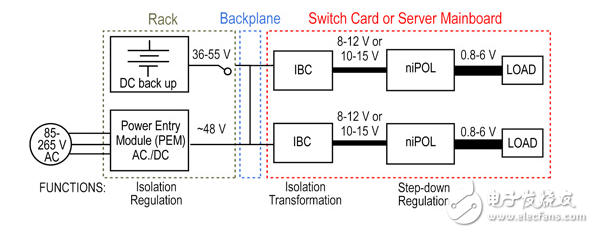
资料下载

分解权力架构(FPA)提供更高的密度、效率和灵活性
分解权力架构(FPA)提供更高的密度、效率和灵活性
压力与每一代新的电子系统一起转换,以最大限度地提高效率、密度和速度。在过去几十年中,为了追求这一目标,电力体系结构从集中式电源架构(CPA)发展到分布式电源(DPA)和中间总线体系结构(IBA),以减少配电损耗,提高整个系统的效率和密度。
虽然图1所示的IBA在一段时间内一直是首选的电源架构,因为它充分解决了整个系统板上的负载扩散问题,但很可能会遇到困难。为什么?因为领先的处理器和存储器现在的特点是低于1 V的电压,电流要求超过100安培,和非常快的瞬态响应。

Figure 1: In the IBA architecture, the intermediate bus converter (IBC) provides isolation and transformation to intermediate voltage. The non-isolated POL (niPOL) regulator provides the final regulated step-down voltage to the load.
However, even under such conditions, power systems designers are challenged to provide high density, high efficiency solutions that cost effectively offer the desired electrical performance. Overcoming such uphill battles of rising power consumption and cost is forcing designers to look beyond IBA to alternative solutions.
To surmount the limitations of traditional AC to DC converters and distributed architectures, along with meeting new, emerging system requirements – higher power density at higher input voltages, lower output voltages, and higher load currents and efficiencies – requires totally new, integrated approaches. Toward that end, Vicor has developed a novel proprietary solution called factorized power architecture (FPA)。 According to Vicor’s white paper¹ entitled “Factorized Power Architecture and V•I Chips”, FPA retains every desirable attribute of CPA, DPA and IBA. However, by disintegrating the classic function of DC-DC converters, FPA and its novel power conversion building blocks, PRMs and VTMs, are capable of providing efficient power system solutions from the wall plug to the processor core.
声明:本文内容及配图由入驻作者撰写或者入驻合作网站授权转载。文章观点仅代表作者本人,不代表电子发烧友网立场。文章及其配图仅供工程师学习之用,如有内容侵权或者其他违规问题,请联系本站处理。 举报投诉
- 相关下载
- 相关文章




